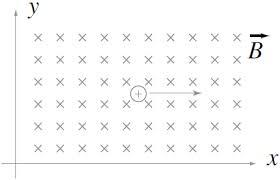Foolish α Particle in Variable Magnetic Field
 Let a
variable
magnetic field exist in
X
Y
Z
plane only in 1st quadrant, such that its magnitude is varying with distance
x
(
B
=
B
0
x
)
and direction in positive
Z
-axis.
Let a
variable
magnetic field exist in
X
Y
Z
plane only in 1st quadrant, such that its magnitude is varying with distance
x
(
B
=
B
0
x
)
and direction in positive
Z
-axis.
Now an α -particle of mass m and charge q enters in this magnetic field at origin with velocity V 0 and direction in positive X -axis.
Then find the radius of curvature of trajectory of particle at the instant when the particle displaced maximum distance in X -direction
Details and assumptions
1) B 0 = 1 . 6 7 × 1 0 − 2 7 T
2) V 0 = 1 . 2 8 × 1 0 − 1 8 m / s
3) m α = 6 . 6 8 × 1 0 − 2 7 K g
4) q α = 3 . 2 × 1 0 − 1 9 C
This is Part of set Foolish Things
The answer is 2.828.
This section requires Javascript.
You are seeing this because something didn't load right. We suggest you, (a) try
refreshing the page, (b) enabling javascript if it is disabled on your browser and,
finally, (c)
loading the
non-javascript version of this page
. We're sorry about the hassle.
2 solutions
Excellent approach...!!
Nice Work... I used Force analysis but your approach is nice...Thanks For Sharing. And I said alpha Particle Foolish Becoz if it had to Come return by travelling some distance then why initially It had Travels in X-direction. I know this is funny but i want to create Series Of question Of This type name so i choose that Title :P
And You May solved my other questions Of this "FOOLISH" Type named. If you NOT solved them previously. I have posted 2 other questions of this Type.
Log in to reply
When i tried force analsys, the resultant differential equation did not seem to have an easy analytical solution, and so i resorted to indirect tricks,, so do post your solution so we can learn how u handled it,, :)
and yes i did solve your foolish proton in cyclotron question
Log in to reply
ya sure i will post it soon... since it takes lot of time..but when i have some time then i post full solution definitely
Log in to reply
@Deepanshu Gupta – dx=(mv cosa da/qBx) Therefore Xdx=mv.cosa da/qB(integrate for a=0to π/2) x²/2= mv/qB X=√(2mv/qB) But i did nt got 2√2, i was getting 0.4(√2)
Log in to reply
@Ace Pilot – Oh. I got it, it was asking for radius and nt max. x Seems i am more foolish than dis alpha particle
U can write force equation and use kinetic energy conservation since magnetic forces do no work. That will give the answer easily
Nice approach! :) I used Force method!
Log in to reply
instead of d(sin (theta) ) he should write (sin d(theta)). should'nt he?
Log in to reply
I too am getting a bit confused in that . Let me think upon it again (later) :)
i know what he did but there is a great confusion in my mind , in eq 1 he wrote (sin d(theta) ) as d(sin theta) but if i take the approximation and write sin d(theta) as just d(theta) the l.h.s would be pi/2 which would be certainly wrong.what do you think @Prakhar Bindal . meanwhile i did it correctly using force method.
i did it using force approach.
Let particle has velocity v and u at any instant. (v along x and u along y)
Writing force equations
-qBxv/m = du/dt = udu/dy
qBxu/m = dv/dt = vdv/dx
Also using energy conservation v^2 + u^2 = (vo)^2
Substitute value of u in first equation and integrate from 0 to x and velocity from (vo) to zero as at maximum x coordinate velocity will be zero. (x velocity obviously)
Now just apply formula of radius of curvature to get required answer
I used the same method bro! :)
Log in to reply
count me in too , i used the same method! ⌣ ¨
I am minority lol.
The speed of particle remains constant since it is a magnetic field and magnetic field exerts force always along a direction perpendicular to velocity , hence at any instant , The radius of curvature is given by
q B x m v
now,, when it passes through a thin element dx
it deviates by
a small angle d(theta)
given by
d ( s i n ( θ ) ) = R d x
substituting the value of R we get
d ( s i n ( θ ) ) = m v q B x d x .......(1)
Now when it reaches the maximum distance along x-axis, Its velocity has no component along x-axis or it is perpendicular to x-axis ,,
hence ,, from the beggining ,, it has deviated by an angle of 90 degrees
so integrating eqn ... (1) from 0 to pi/2 for RHS and from 0 to 'a' for LHS
We get
1 = 2 m v q B a 2 o r a = q B 2 m v
Now using the formula for R
we get
R = 2 q B m v
which is nothing but
2 2 = 2 . 8 2 8 4 7 1 2 5
and why is the alpha particle foolish ?